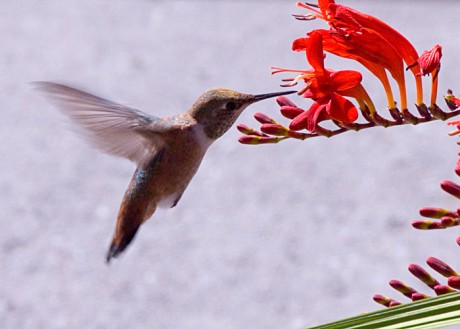Hummingbird Arrival
Posted March 12, 2016 at 8:40 am by Tim Dustrude
Richard W. Wright shares this article on hummingbirds…
Hummingbird season is upon us. The little migratory Rufous Hummingbird has returned from its usual wintering grounds in Mexico. Hordes of Rufous Hummingbirds will pass through our area on their way north to SE Alaska, but many will stay here to breed and raise young. The Annas Hummingbird is the second hummingbird species that frequent our islands. They are not migratory and they will hang around all winter, especially if fed at feeders.
It is very important to keep our feeders clean and, especially, to keep out black mold. Black mold is dangerous to the health of hummers and can kill them. It is recommended by most hummingbird experts to kill the mold in your feeders periodically, at least once a month. To kill the mold, soak the feeder in a solution of bleach and water (1/4 cup to a gallon of water) for an hour or so. Just be sure to rinse thoroughly afterward. Full strength vinegar can also be used as an alternative to bleach.
The ratio of sugar to water should be 1 to 4. An example would be one cup of sugar to 4 cups of water. Cane sugar (sucrose) is preferred. Do not use honey, brown sugar, or red dye. Honey will ferment fast and can kill the hummers. Brown sugar can have impurities in it. Red dye is also potentially problematic. It may cause tumors, though this is not proven…yet. But why take the chance? Don’t use it. It is important not to let the nectar sit too long, allowing it to ferment. Change it at least once a week; more often in hot weather. Sugar nectar is basic fuel for hummers. It gives them the energy to hunt for their protein source… small insects and spiders.
In choosing a feeder, find one that is easy to clean. Avoid feeders with yellow “flowers”. Yellow will attract bees, wasps, and yellow jackets. Basin type feeders (such as the HummZinger) are easy to clean. Hummers can feed at them, but bees, wasps, and yellow jackets can’t reach the nectar to feed.
Enjoy our little island jewels. They are amazing birds and fun to watch.
Richard W. Wright
You can support the San Juan Update by doing business with our loyal advertisers, and by making a one-time contribution or a recurring donation.
Categories: Around Here
One comment:











One comment...
Good information! We feed the hummers all year long and are vigilant about the feeder cleanliness and fresh food supply; however, the “recipe” for destroying the black mold was new information and is very helpful. Thank you!
By submitting a comment you grant the San Juan Update a perpetual license to reproduce your words and name/web site in attribution. Inappropriate, irrelevant and contentious comments may not be published at an admin's discretion. Your email is used for verification purposes only, it will never be shared.